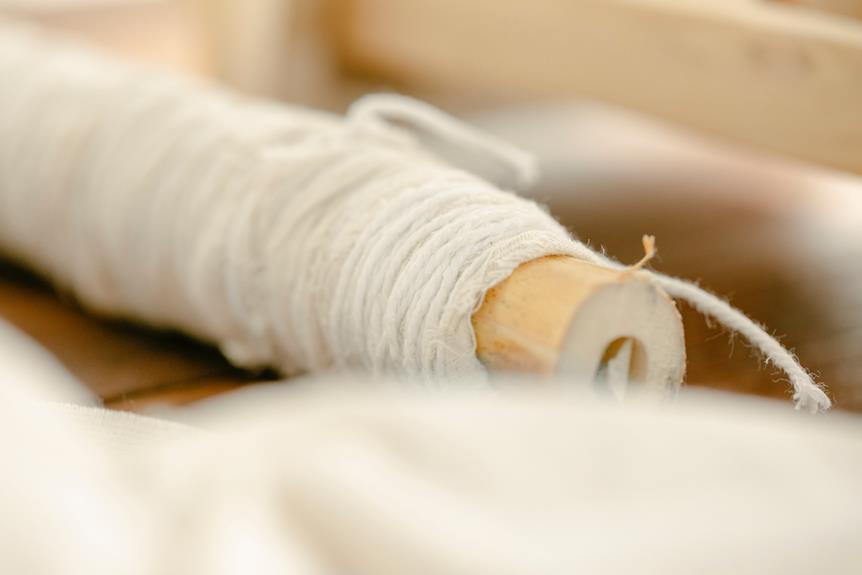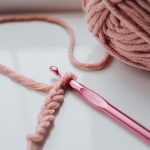Hey there! Ever wondered if double stick tape can be used on fabric? It's a common question, especially when you're aiming for a flawless look with your fabric projects. The good news is that double stick tape can indeed be used on fabric, and it can be a game-changer for creating clean, seamless finishes.
Whether you're hemming garments, crafting home decor, or working on other fabric projects, knowing how to properly use double stick tape on fabric can give you that polished, professional touch. Stick around to learn about the advantages, types of fabric suitable for double stick tape, application techniques, precautions, and more.
Let's master the art of using double stick tape on fabric!
Key Takeaways
- Double stick tape provides a quick and convenient way to secure hems and seams on fabric without the need for sewing.
- Cotton, polyester, blends, and heavier fabrics like denim or wool are suitable for double stick tape, while delicate fabrics like silk or lace should be tested first.
- To apply double stick tape on fabric, choose a tape suitable for fabric, clean and dry the fabric surface, use fabric-safe adhesion techniques, and press down firmly for a strong bond.
- Precautions and maintenance include testing a small area of fabric, using gentle tape for delicate fabrics, considering the duration of tape usage, being mindful of heat and washing, and proper care and maintenance for longevity of the bond.
Advantages of Using Double Stick Tape on Fabric
One major advantage of using double stick tape on fabric is that it provides a quick and easy way to temporarily secure hems and seams without the need for sewing. This can be particularly useful when you need a quick fix or alteration and don't have the time to sew. Additionally, double stick tape can be used for creating temporary costumes or garments for events like Halloween or costume parties. It's a convenient alternative to sewing for those who may not have the skills or equipment for traditional sewing.
Another advantage is the durability of double stick tape. When applied correctly, it can withstand regular wear and tear, making it suitable for temporary fixes on clothing or fabric items. However, it's important to note that double stick tape may not be as durable as sewing for long-term use.
In terms of maintenance, using double stick tape on fabric is relatively low maintenance. There's no need to worry about thread tension, needles, or bobbins. It's a quick and hassle-free way to achieve temporary fabric alterations.
Types of Fabric Suitable for Double Stick Tape
You can use double stick tape on a variety of fabrics, including cotton, polyester, and blends. When choosing a fabric for double stick tape, it's important to consider the adhesive strength of the tape and the texture of the fabric.
Lighter fabrics such as cotton and polyester work well with most types of double stick tape due to their smooth and even surface, which provides a good bonding area for the adhesive. Blends, such as cotton-polyester blends, also work effectively with double stick tape due to their balanced combination of fibers, offering a suitable surface for the adhesive to adhere to.
For heavier fabrics like denim, canvas, or wool, it's essential to select a double stick tape with a stronger adhesive to ensure a secure hold. These fabrics have a more textured and uneven surface, requiring a tape with higher adhesive strength to effectively bond to the fabric.
When working with delicate fabrics like silk or lace, it's crucial to test the double stick tape on a small, inconspicuous area to ensure that it doesn't damage or leave residue on the fabric.
Always consider the type of fabric and its texture when choosing the appropriate double stick tape for your project.
How to Apply Double Stick Tape on Fabric
To apply double stick tape on fabric, start by choosing a tape that's suitable for fabric.
Make sure to clean and dry the fabric surface before applying the tape for a secure hold.
Use fabric-safe adhesion techniques to ensure that the tape adheres well without causing damage to the fabric.
Tape for Fabric Versatility
You'll need a strip of double stick tape approximately the same length as the area you want to bond on the fabric. To apply the tape on fabric, follow these simple steps:
| Step | Instructions |
|---|---|
| 1 | Cut the double stick tape to the desired length. |
| 2 | Peel off one side of the tape's protective backing. |
| 3 | Carefully place the exposed adhesive side of the tape onto the fabric. |
| 4 | Gently press down on the tape to ensure it adheres securely to the fabric. |
Applying Tape Securely
Achieving secure adhesion when applying double stick tape on fabric is essential for ensuring a long-lasting bond.
To secure hems or make temporary fixes, start by ensuring that the fabric is clean and dry.
Cut the tape to the desired length, and carefully apply it to the fabric, pressing firmly to ensure strong adhesion.
For securing hems, fold the fabric to the desired hem length and then apply the tape along the fold, pressing firmly to secure it in place.
When using double stick tape for temporary fixes, ensure that both surfaces are clean and free of any residue, as this can affect the tape's adhesion.
Following these steps will help you apply double stick tape securely on fabric for a reliable and long-lasting hold.
Fabric-Safe Adhesion Techniques
For secure adhesion when applying double stick tape on fabric, ensure that the fabric is free from any debris or residue. Start by preparing the fabric, ensuring it's clean and dry.
Press the double stick tape firmly onto the fabric, running your fingers over the tape to secure it in place.
If you're concerned about the tape leaving residue or damaging the fabric, there are adhesive alternatives available, such as fabric-friendly double stick tape or fabric glue. These alternatives provide a secure hold without risking damage to the fabric.
When using any adhesive on fabric, always test it on a small, inconspicuous area first to ensure it doesn't cause any unwanted effects.
Following these fabric-safe adhesion techniques will help you achieve a strong and secure bond without compromising the integrity of the fabric.
Precautions When Using Double Stick Tape on Fabric
When using double stick tape on fabric, it's important to consider the compatibility of the tape with the fabric and the potential for damage.
Additionally, be mindful of the impact of heat and washing on the adhesive and the fabric.
Taking these precautions can help ensure the effective and safe use of double stick tape on fabric.
Fabric Compatibility and Damage
You can prevent fabric damage by testing a small, inconspicuous area before using double stick tape on fabric. This is crucial because fabric durability varies, and some fabrics may not withstand the adhesive strength of double stick tape.
It's important to consider the type of fabric you're working with and its ability to handle adhesives. When using double stick tape on fabric, take precautions to avoid any potential damage. For delicate fabrics, it's advisable to use a gentle, fabric-friendly double stick tape specifically designed for such materials.
Additionally, be mindful of how long the tape will be in place, as extended use may increase the risk of damage. By taking these precautions, you can effectively use double stick tape on fabric without causing any harm.
Heat and Washing Considerations
Before applying double stick tape on fabric, it is important to consider the potential effects of heat and washing on the adhesive bond. Proper care and maintenance can help ensure the longevity of the bond between the fabric and the tape. Here are some key considerations:
| Heat Resistance | Adhesive Strength | Washing Instructions |
|---|---|---|
| Check the tape's heat resistance to ensure it can withstand the intended temperature, especially if the fabric will be ironed. | Ensure the adhesive strength is not compromised by heat; some tapes are specifically designed for high-temperature applications. | Follow the manufacturer's washing instructions to maintain the adhesive strength and prevent premature tape loosening. |
| Use a pressing cloth when ironing over the tape to protect both the fabric and the adhesive. | Avoid exposing the tape to excessive heat for prolonged periods, as it may weaken the bond over time. | If possible, opt for hand washing or gentle machine cycles to minimize stress on the tape bond. |
Considering these factors will help you maintain the integrity of the adhesive bond when using double stick tape on fabric.
Removing Double Stick Tape Residue From Fabric
To remove double stick tape residue from fabric, start by carefully peeling off the tape.
Then, gently rub the affected area with a clean cloth soaked in rubbing alcohol. This will help to lift and dissolve the adhesive residue without damaging the fabric.
After rubbing the area with rubbing alcohol, wash the fabric according to its care instructions to remove any remaining residue and alcohol.
If the fabric is delicate or if the residue is stubborn, you can also try using a gentle fabric stain remover, following the product's instructions.
Always test any cleaning method on a small, inconspicuous area of the fabric first to ensure it doesn't cause any damage or discoloration.
Once the residue is gone, allow the fabric to air dry or follow the care instructions for drying.
It's important to be patient and gentle when removing residue from fabric to avoid causing any damage or spreading the adhesive further.
Tips for Maximizing the Effectiveness of Double Stick Tape on Fabric
For maximum effectiveness of double stick tape on fabric, ensure that it's firmly pressed onto the fabric surface for at least 30 seconds to secure a strong bond. Maximizing adhesion of double stick tape on fabric is essential for its effectiveness.
Here are three tips to help you get the most out of using double stick tape on fabric:
- Clean the Fabric Surface: Before applying double stick tape, ensure that the fabric surface is clean and free from any dust, lint, or oils. This will help the tape adhere better and create a stronger bond with the fabric.
- Use the Right Amount of Tape: Avoid using too little or too much tape. Using too little may not provide enough adhesion, while using too much can make the fabric stiff or cause the tape to be visible. Use the appropriate amount for the specific task at hand.
- Follow Fabric Care and Maintenance Instructions: Different fabrics have different care and maintenance requirements. Always follow the care instructions for the fabric to ensure that the double stick tape application doesn't damage or compromise the fabric's integrity.
Frequently Asked Questions
Can Double Stick Tape Be Used on Delicate Fabrics Like Silk or Chiffon?
Using double stick tape on delicate fabrics like silk or chiffon can be risky as it may damage the fabric. Instead, consider alternatives like fabric glue or hand-sewing for a secure and fabric-friendly hold.
Will Double Stick Tape Damage the Fabric or Leave Behind Residue?
Double stick tape is great for fabric preservation as it has strong adhesive strength. It's compatible with most fabrics and won't leave behind residue if removed carefully. Just be cautious when using it on delicate materials.
Can Double Stick Tape Be Used to Hem or Mend Fabric on Clothing Items?
You can use double stick tape for temporary fabric bonding or clothing repair. It's a sewing alternative for quick fixes. However, for a more durable solution, sewing is recommended. Double stick tape is a handy temporary solution.
Is Double Stick Tape Strong Enough to Hold Heavy Fabrics Like Denim or Upholstery Material?
Yes, double stick tape can be strong enough to hold heavy fabrics like denim or upholstery material. Its fabric strength and adhesive durability make it suitable. Ensure proper application techniques for best results, or consider alternative solutions for heavy-duty fabric.
Can Double Stick Tape Be Used to Temporarily Attach Fabric to Other Surfaces, Such as for Crafting or DIY Projects?
Yes, double stick tape can be used to temporarily attach fabric to other surfaces for crafting or DIY projects. It provides a quick and easy alternative for fabric bonding, making it great for various tape applications in fabric projects.
- Tetron Fabric for Marine Applications: Durability and Use Cases - June 18, 2025
- Tetron Fabric for Outdoor Furniture: Weather Resistance and Care - June 18, 2025
- Tetron Fabric for Wall Coverings: Style and Application Tips - June 18, 2025





